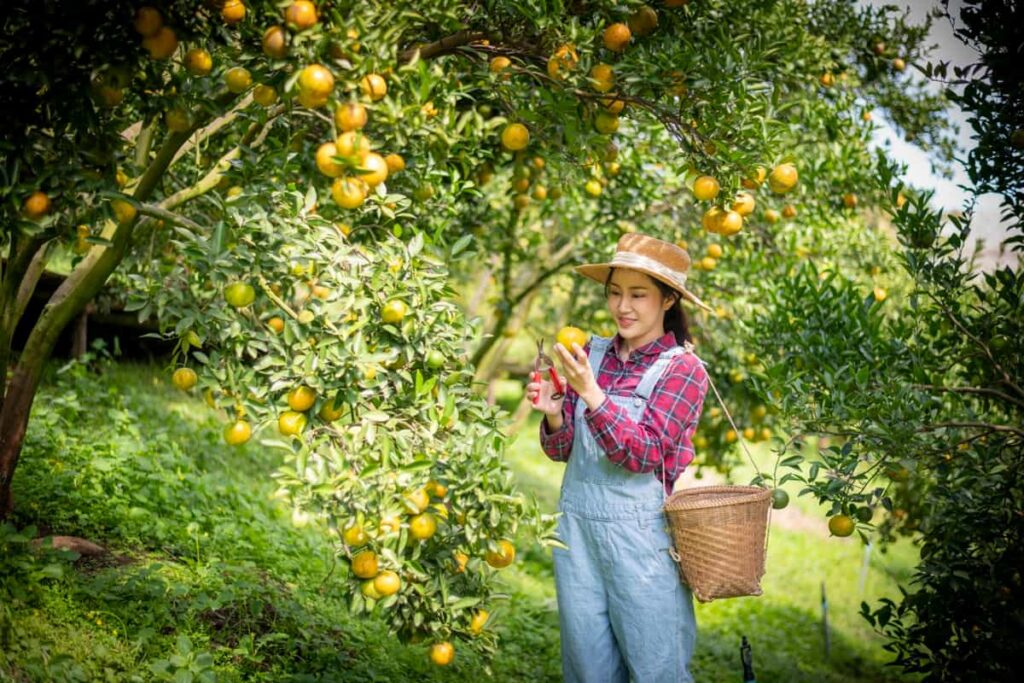Achieving optimal citrus fruit size involves a combination of careful cultivation practices and environmental considerations. This guide explores key factors influencing citrus fruit growth, such as proper fertilization, irrigation, and pest management. By understanding the intricacies of citrus tree development, growers can implement strategies to enhance fruit size, ultimately leading to a more bountiful harvest and improved overall crop quality.

How to Increase Citrus Fruit Size
Essential Nutrients for Maximizing Citrus Fruit Growth
Citrus nutrition for bigger fruits is crucial in achieving optimal results. To ensure Citrus fruit size enhancement and larger yields, it’s imperative to understand the specific nutrients that play a pivotal role in citrus fruit development. Citrus trees thrive on a balanced diet of essential elements, including nitrogen, phosphorus, and potassium. They contribute to the overall health of the tree and, in turn, influence the size of the fruits produced. Implementing a tailored fertilization plan enriched with micronutrients like zinc and magnesium further enhances citrus fruit development.
Innovative Irrigation Techniques for Larger Citrus Fruits
Citrus watering methods for large fruits are pivotal in optimizing Citrus Fruit Growth. Adopting innovative irrigation techniques is crucial for ensuring that citrus trees receive adequate water, a fundamental component in achieving larger and juicier fruits. Drip irrigation systems, designed to deliver water directly to the root zones, promote efficient water usage and minimize wastage.
Also, implementing soil moisture sensors enables growers to monitor and adjust irrigation schedules, ensuring a consistent supply of water throughout the growing season. Employing these Citrus fruit growth techniques not only supports the development of larger fruits but also contributes to overall orchard sustainability. By integrating advanced irrigation methods, citrus growers can enhance fruit size, quality, and the overall productivity of their orchards.
Optimizing Soil Quality for Increased Citrus Size
Citrus soil preparation for bigger fruits is a critical step in achieving Citrus fruit size improvement. Begin by conducting a thorough soil analysis to understand its composition and identify any deficiencies. Incorporate organic matter, such as well-rotted compost, to enhance soil fertility and structure. Adjust pH levels to the citrus tree’s preferred range, typically between 6 and 7. Implementing cover crops and mulching helps retain moisture and suppress weeds, contributing to optimal soil conditions.
Effective Fertilization Strategies for Bigger Citrus
Citrus fertilization for bigger fruit size is a key element in successful citrus large fruit cultivation. Developing a strategic and well-balanced fertilization plan is essential to provide citrus trees with the nutrients they need for optimal growth and larger fruit production. A mix of nitrogen(N), phosphorus(P), and potassium(K) is fundamental in supporting robust tree development, with an emphasis on potassium for fruit size enhancement.
Utilizing slow-release fertilizers ensures a continuous supply of nutrients over an extended period. Incorporating organic fertilizers, like compost or well-rotted manure, adds valuable micronutrients to the soil. Regular soil testing guides growers in fine-tuning nutrient applications with respect to the specific requirements of their orchards.
In case you missed it: 15 Best Fertilizers for Citrus Tree: Homemade, Organic, Liquid, NPK, Schedule, and Prices

Pruning Practices to Encourage Larger Citrus Yield
Citrus Pruning Techniques for Large Fruits play a crucial role in the pursuit of optimal harvest. Pruning is a strategic horticultural practice that not only shapes the tree but also influences Citrus fruit size maximization. Begin by removing dead or diseased branches to improve overall tree health and redirect energy towards fruit-bearing branches.
Thin out excess foliage to enhance air circulation and sunlight penetration, promoting uniform fruit development. Focus on shaping the canopy to create an open structure that allows for better light distribution throughout the tree. Timing is key; conduct pruning during the dormant season to minimize stress on the tree.
The Role of Climate in Enhancing Citrus Fruit Size
Understanding the impact of citrus climate on fruit size is crucial for effective citrus fruit growth optimization. Adequate sunlight is essential for photosynthesis and the production of sugars, contributing to citrus fruit growth optimization and sweetness. Consistent temperatures within the citrus tree’s preferred range, typically between 21-29°C, support optimal growth.
In regions where cold temperatures are a concern, providing frost protection measures ensures the trees are safeguarded during critical periods. By comprehending the nuances of Citrus Climate Impact on Fruit Size, growers can make informed decisions to create a favorable environment that fosters the maximum potential for citrus fruit development.
Organic Approaches to Boosting Citrus Fruit Dimensions
Embracing organic citrus farming for bigger fruits offers a sustainable path to citrus fruit size expansion. Organic practices focus on nurturing soil health, utilizing natural fertilizers like compost and organic amendments. Employ cover crops and crop rotations to enhance soil structure and fertility, promoting a balanced ecosystem for citrus trees. Integrated pest management strategies, such as beneficial insect release, help control pests without compromising fruit quality.
Also, organic growers prioritize water conservation, using mulching and efficient irrigation techniques. By choosing Organic Citrus Farming for Bigger Fruits, growers not only contribute to environmental stewardship but also unlock the potential for citrus fruit size expansion.
Pest and Disease Management for Healthier, Larger Citrus
Implementing citrus pest control for healthy big fruits is paramount in ensuring citrus fruit growth protection. Regular monitoring of orchards enables early detection of potential threats, allowing for prompt intervention. Utilize integrated pest management (IPM) techniques, which may include natural predators, cultural practices, and, if necessary, organic pesticides to control pests without compromising fruit quality.
Prune and dispose of infected plant material to prevent the spread of diseases. Applying preventive measures, such as copper-based fungicides, creates a protective barrier against common citrus diseases. By prioritizing comprehensive Citrus Pest Control for Healthy Big Fruits, growers safeguard their orchards, ensuring not only larger fruit sizes but also the overall health and resilience of the citrus trees.
Advanced Agricultural Technologies for Citrus Size Increase
Harnessing Citrus Growth Technology for Bigger Fruits represents a significant stride in high yields. Modern agriculture offers a range of innovative technologies that can be leveraged to optimize Citrus fruit size innovation and maximize yields. Precision agriculture techniques, including sensor-based monitoring and automated irrigation systems, enable growers to tailor water and nutrient delivery precisely to the specific needs of individual trees.
In case you missed it: How to Increase Guava Fruit Size: Management for Getting Bigger Guava Fruits

Implementing controlled environment agriculture, such as greenhouses or hydroponic systems, provides a more controlled setting for citrus growth, enhancing fruit size and quality. Additionally, the use of genetic technologies, like selective breeding and genetic modification, offers opportunities to develop citrus varieties with superior size characteristics.
Cultivar Selection for Maximizing Citrus Fruit Size
Choosing bigger citrus varieties is a pivotal step in achieving citrus fruit size enhancement. The selection of the right cultivar is a fundamental aspect of citrus cultivation, influencing the ultimate size and quality of the fruits. Selecting citrus cultivars with characteristics such as large fruit size, like the “Eureka” or “Lisbon” varieties for lemons or “Washington Navel” for oranges, can maximize citrus fruit size. By making informed decisions in Cultivar Selection, growers can optimize their orchards for larger citrus fruits, ultimately enhancing the market value and consumer appeal of their citrus crops.
In case you missed it: Fruit Size Management: How to Get Bigger Fruits and Techniques for Increasing Fruit Size

Conclusion
The journey to maximize citrus fruit size involves a multifaceted approach, encompassing essential nutrients, innovative irrigation, soil optimization, effective fertilization, strategic pruning, climate considerations, organic farming practices, pest management, advanced technologies, and careful cultivar selection. By embracing these elements collectively, citrus growers can unlock the full potential of their orchards, cultivating larger fruits.
- Management Pests and Diseases in Your Cotton Field
- Sheep Farming Business Plan for Beginners
- Aquaponic Farming at Home: A Step-By-Step Guide
- Profitable Village Farming Business Ideas in 2024
- High-Yield Aquaculture: Fast-Growing Fish for Farming
- Effective Fish Pond Construction Techniques for Beginners
- Irrigation and Water Management in Pineapple Farming
- Blossom to Harvest: Mastering Flowering and Pollination in Papaya Farming
- Pig Fattening Essentials: From Selection to Sale for Beginners
